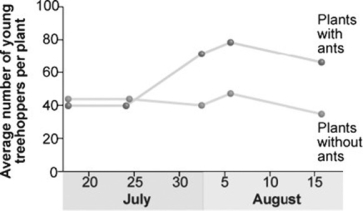A) is caused by suborganismal pathogens such as viruses, viroids, and prions only
B) is caused by pathogens that are transferred from other animals to humans by direct contact or by means of a vector
C) can only be spread from animals to humans through direct contact
D) can only be transferred from animals to humans by means of an intermediate host
Correct Answer

verified
Correct Answer
verified
Multiple Choice
Which of the following could qualify as a top-down control on a grassland community?
A) limitation of plant biomass by rainfall amount
B) influence of temperature on competition among plants
C) influence of soil nutrients on the abundance of grasses versus wildflowers
D) effect of grazing intensity by bison on plant species diversity
Correct Answer

verified
Correct Answer
verified
Multiple Choice
According to the nonequilibrium model of community diversity, ________.
A) community structure remains stable in the absence of interspecific competition
B) communities are assemblages of closely linked species that are permanently changed by disturbance
C) interspecific interactions induce changes in community composition over time
D) communities are constantly changing after being influenced by disturbances
Correct Answer

verified
Correct Answer
verified
Multiple Choice
Use the figure to answer the following question.
 Treehoppers (a type of insect) produce honeydew, which ants use for food. Treehoppers have a major predator, the jumping spider. Researchers hypothesized that the ants would protect the treehoppers from the spiders. During a one-year study, researchers found no difference in treehopper populations in any of their control and experimental groups. What could they measure during the second year to gain information about why this might have occurred?
Treehoppers (a type of insect) produce honeydew, which ants use for food. Treehoppers have a major predator, the jumping spider. Researchers hypothesized that the ants would protect the treehoppers from the spiders. During a one-year study, researchers found no difference in treehopper populations in any of their control and experimental groups. What could they measure during the second year to gain information about why this might have occurred?
A) Measure the number of ant females.
B) Measure the relative sizes of the treehoppers.
C) Measure the relative abundance of jumping spiders.
D) Measure the relative sizes of different ant species.
Correct Answer

verified
Correct Answer
verified
Multiple Choice
Imagine five forest communities, each with one hundred individuals distributed among four different tree species (W, X, Y, and Z) . Which forest community would be most diverse?
A) 25W, 25X, 25Y, 25Z
B) 40W, 30X, 20Y, 10Z
C) 50W, 25X, 15Y, 10Z
D) 70W, 10X, 10Y, 10Z
Correct Answer

verified
Correct Answer
verified
Multiple Choice
The symbols +, -, and 0 are to be used to show the results of interactions between individuals and groups of individuals. The symbol + denotes a positive interaction, - denotes a negative interaction, and 0 denotes where individuals are not affected by interacting. The first symbol refers to the first organism mentioned. What interactions exist between mycorrhizae and evergreen tree roots?
A) +/+
B) +/0
C) +/-
D) 0/0
Correct Answer

verified
Correct Answer
verified
Multiple Choice
Which of the following is an example of Müllerian mimicry?
A) two species of unpalatable butterfly that have the same color pattern
B) a day-flying hawkmoth that looks like a wasp
C) a chameleon that changes its color to look like a dead leaf
D) one species of a non-venomous snake which rattles its tail to mimic a venomous rattlesnake
Correct Answer

verified
Correct Answer
verified
Multiple Choice
In a particular case of secondary succession, three species of wild grass all invaded a field. By the second season, a single species dominated the field and the other two species had a lower relative abundance. A possible factor contributing to the abundances of these species in this example of secondary succession is ________.
A) equilibrium
B) immigration
C) inhibition
D) parasitism
Correct Answer

verified
Correct Answer
verified
Multiple Choice
As you study two closely related predatory insect species, the two-spot and the three-spot avenger beetles, you notice that each species seeks prey at dawn in areas without the other species. However, where their ranges overlap, the two-spot avenger beetle hunts at night and the three-spot hunts in the morning. When you bring them into the laboratory and isolate the two different species, you discover that the offspring of both species are found to be nocturnal. You have discovered an example of ________.
A) mutualism
B) character displacement
C) Batesian mimicry
D) resource partitioning
Correct Answer

verified
Correct Answer
verified
Multiple Choice
Which of the following statements is a likely explanation for why invasive species take over communities into which they have been introduced?
A) Invasive species are less efficient than native species in competing for the limited resources of the environment.
B) Invasive species are not held in check by the predators and agents of disease that have always been in place for native species.
C) Invasive species have a higher reproductive potential than native species.
D) Invasive species come from geographically isolated regions, so when they are introduced to regions where there is more competition, they thrive.
Correct Answer

verified
Correct Answer
verified
Multiple Choice
Keystone predators can maintain species diversity in a community if they ________.
A) competitively exclude other predators
B) prey on the community's dominant species
C) allow immigration of other predators
D) prey only on the least abundant species in the community
Correct Answer

verified
Correct Answer
verified
Showing 61 - 71 of 71
Related Exams